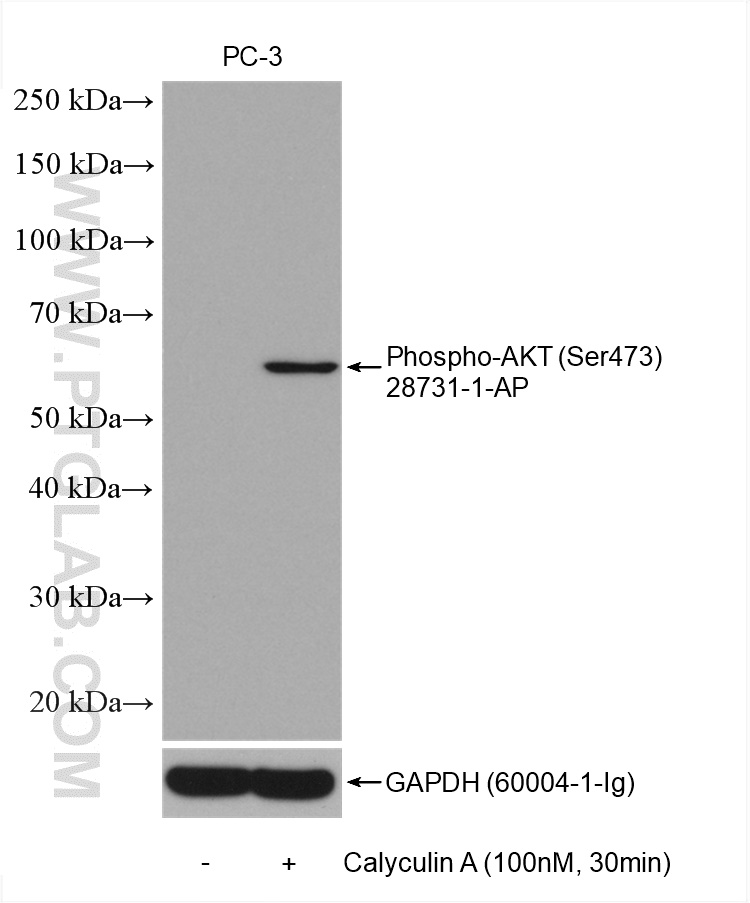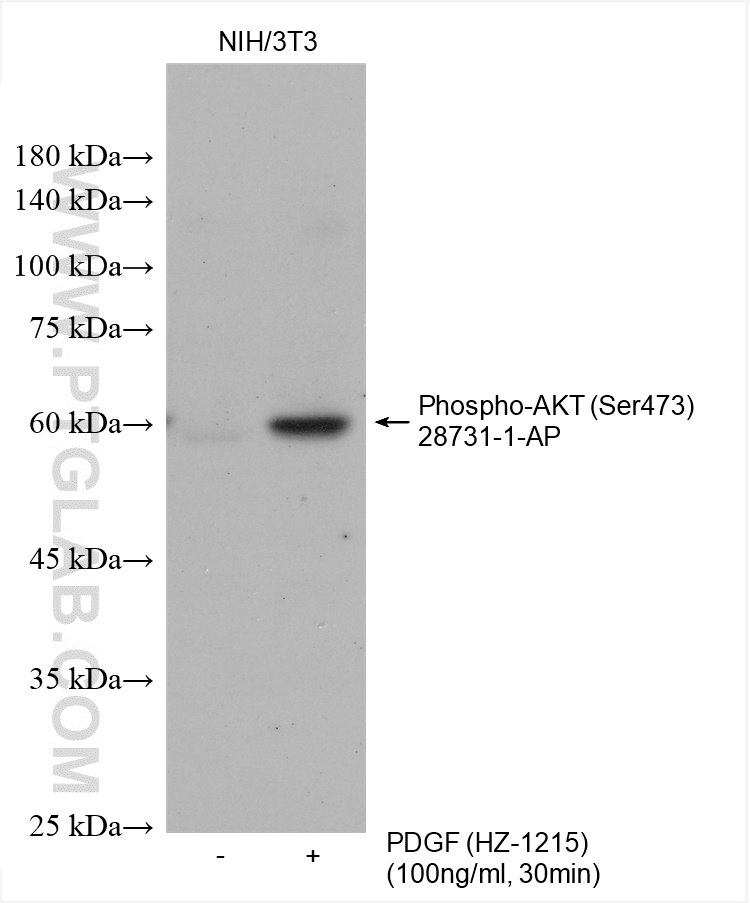Phospho-AKT (Ser473) Polyclonal antibody
Phospho-AKT (Ser473) Polyclonal Antibody for WB, ELISA
Host / Isotype
Rabbit / IgG
Reactivity
Human, mouse, rat and More (2)
Applications
WB, ELISA and More (2)
Conjugate
Unconjugated
验证数据展示
经过测试的应用
| Positive WB detected in | Calyculin A treated PC-3 cells, PDGF treated NIH/3T3 cells |
推荐稀释比
| Application | Dilution |
|---|---|
| Western Blot (WB) | WB : 1:1000-1:5000 |
| It is recommended that this reagent should be titrated in each testing system to obtain optimal results. | |
| Sample-dependent, Check data in validation data gallery. | |
产品信息
28731-1-AP targets Phospho-AKT (Ser473) in WB, IF, IHC, ELISA applications and shows reactivity with Human, mouse, rat samples.
| Tested Applications | WB, ELISA |
| Cited Applications | WB, IF, IHC |
| Tested Reactivity | Human, mouse, rat |
| Cited Reactivity | human, mouse, rat, pig |
| Immunogen | Peptide 种属同源性预测 |
| Host / Isotype | Rabbit / IgG |
| Class | Polyclonal |
| Type | Antibody |
| Full Name | v-akt murine thymoma viral oncogene homolog 1 |
| Synonyms | AKT, AKT1, Phospho-AKT (Ser473), PKB, PKB ALPHA, PRKBA, Protein kinase B, Proto oncogene c Akt, RAC, RAC ALPHA, RAC PK alpha |
| Observed Molecular Weight | 58 kDa |
| GenBank Accession Number | NM_005163 |
| Gene Symbol | AKT1 |
| Gene ID (NCBI) | 207 |
| RRID | AB_2881201 |
| Conjugate | Unconjugated |
| Form | Liquid |
| Purification Method | Antigen affinity purification |
| UNIPROT ID | P31749 |
| Storage Buffer | PBS with 0.02% sodium azide and 50% glycerol pH 7.3. |
| Storage Conditions | Store at -20°C. Stable for one year after shipment. Aliquoting is unnecessary for -20oC storage. |
背景介绍
实验方案
| Product Specific Protocols | |
|---|---|
| WB protocol for Phospho-AKT (Ser473) antibody 28731-1-AP | Download protocol |
| Standard Protocols | |
|---|---|
| Click here to view our Standard Protocols |
发表文章
| Species | Application | Title |
|---|---|---|
Toxicology Toxicity mechanism of peri-implantation pesticide beta-cypermethrin exposure on endometrial remodeling in early pregnant mice | ||
Phytomedicine Combinational application of the natural products 1-deoxynojirimycin and morin ameliorates insulin resistance and lipid accumulation in prediabetic mice | ||
Biomed Pharmacother Preclinical characterization of danatinib as a novel FLT3 inhibitor with excellent efficacy against resistant acute myeloid leukemia | ||
Cell Biosci Serine protease PRSS56, a novel cancer-testis antigen activated by DNA hypomethylation, promotes colorectal and gastric cancer progression via PI3K/AKT axis | ||
Biomed Pharmacother Cinnamaldehyde protects donor heart from cold ischemia-reperfusion injury via the PI3K/AKT/mTOR pathway | ||
Bioeng Transl Med Identification of PIK3CG as a hub in septic myocardial injury using network pharmacology and weighted gene co-expression network analysis |

